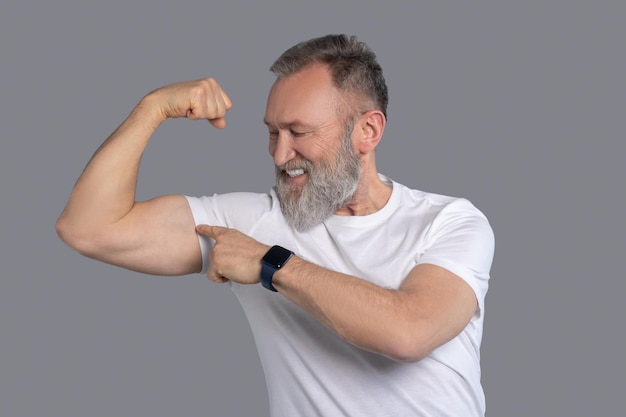Have you ever thought that heavy weightlifting is only for bodybuilders, power lifters or certain types of athletes? Well, in today's post, we're going to find that this is definitely not the case and no matter who you are you should likely be including some form or variation of heavy resistance training into your routine. Now, you still might be pushing back and saying "wait a minute Jonathan, I do things like consistent long distance running,
Save Your Muscles From Aging Topics List :
- How Much Muscle Do We Lose With Age?
- Fast-Twitch & Slow Twitch - How a Muscle is Put Together:
- You Lose More Fast-Twitch Muscle Fibers With Age:
- Monitoring Blood Glucose Levels - Nutrisense!
- Grouping Muscle Fibers Into Motor Units:
- Why Heavy Weights Are Needed to Stimulate Fast Twitch Fibers:
- Why Being Active With Daily Activities Still Isn't Enough:
- Why Certain Exercise Types Don't Combat Muscle Mass Reduction:
- Best type of Resistance Training to Preserve Muscle Mass (Volume, Load, etc.)
- Getting Creative With Exercise: Weights + Explosive Movements
- Will You Get "Too Big" With This Type of Training?
- Protecting Your Foot Speed As You Age - Reduce the Falls:

throw in some weight training throughout the week but it's of a lighter weight or lighter load, maybe even throwing in some yoga in there". Well, still probably not enough. We'll talk about why this is by taking a look at the muscles, discussing aging and of course, talk about how we could add this type of training to a current routine or even a new routine. It's going to be an important one, so, let's jump right into this anatomical awesomeness.
How Much Muscle Do We Lose With Age?
So, first let's start with the "why". Why do these skeletal muscles require heavy resistance training and therefore why should all of us participate in this? Well, maybe you've heard some alarming statistics that starting in our 30s, we can lose anywhere from three to five percent of our muscle mass per decade but when we get to our 50s, we can lose as much as 10% of our muscle mass per decade. That's quite alarming and kind of scary to think about but you might also be thinking "well wait, can't we combat that or at least slow that process down through exercise?
" and the answer is yes and that's one of the main points of this video but many of the other forms of exercise just aren't as effective at preserving muscle mass like heavy resistance training is. So why is heavy resistance training better at preserving muscle mass than the other types of exercise? Well, the answer to that lies in how muscles actually work. So, let's use the biceps
Fast-Twitch & Slow Twitch - How a Muscle is Put Together:

brachii muscle as our example here but keep in mind we can apply this information to any of the other skeletal muscles that we would be working out or exercising but if we were to take a look at this whole biceps muscle, the whole muscle is going to be made up of thousands of string like cells called Muscle Fibers and you could just even call them muscle cells. So, if I use those terms interchangeably we're talking about the same thing but these muscle fibers have an amazing ability to contract and when they contract, this would cause a pulling on the bone via the tendon and that would
move your skeleton in certain directions depending on what muscle you're contracting. Now, another thing that's important that we talk about with these muscle fibers is that if we analyze the muscle fibers within this muscle, we would see that some of them are classified as fast twitch muscle fibers and others are classified as slow twitch muscle fibers and this is definitely important to our muscle mass story. So, why do the different fiber types matter when it comes to a reduction in muscle mass.
You Lose More Fast-Twitch Muscle Fibers With Age:
as we age? Well, let's go over some of the characteristics of these fiber types and then we'll bring that together. The fast twitch muscle fibers, as the name implies, contract with more velocity and more force and tend to have a greater diameter when compared to the slow twitch fibers. Now, one of the dry backs of the fast twitch fibers is that they fatigue rather quickly and we do have to acknowledge to all the anatomy and physiology Geeks out there that we could further classify or subdivide the fast twitch fibers but that's for another time. The slow twitch fibers contract with less velocity, less force and have a smaller diameter but they are fatigue resistant; they're great for endurance type activities. So again, how does this relate to reduction of muscle mass as we age? When we have this reduction of muscle

mass, it's not like the mass reduction is uniform between the fiber types and what I mean by that is it's not like 50% of that reduction in muscle mass comes from the slow twitch if the other 50 comes from the fast twitch. It is actually much more biased to the fast twitch fibers meaning we lose a much greater proportion of the fast twitch fibers as we age as compared to the slow twitch fibers. So, this probably raises another question for you; why do we lose such a greater proportion of the fast twitch fibers versus the slow twitch fibers with aging? Well, a big part of this answer has to do with the sequence in which the nervous system recruits the slow twitch fibers versus how it recruits the fast twitch fibers and this will also help us to understand why certain activities do a better job at recruiting or engaging those fast twitch fibers. So, let's get into this by talking about the nervous system, motor recruitment and pencils[00:04:09] but real quick I want to talk about this cool device on.
Monitoring Blood Glucose Levels - Nutrisense!

the back of my arm by saying thank you to the sponsor of today's video Nutrisense. Nutrisense is a continuous glucose monitoring program that monitors your blood sugar levels which are more appropriately referred to as your blood glucose levels. It does it through this nifty little device called a Continuous Glucose Monitor or CGM that goes on the back of your arm or for you anatomy nerds out there, on the posterior brachium. The CGM then easily syncs with the nutrisense app which allows you to monitor your blood glucose levels throughout the day and see how things like food, sleep, exercise and even how stress impacts your blood glucose levels. For me, it was very interesting and a lot of fun to do little foods experiments to see which types of foods might spike my blood glucose levels. Probably not a big shocker what that ice cream was going to do but it was also
awesome to see how exercise, like stimulating those fast twitch muscle fibers could affect those blood glucose levels which could help provide valuable Insight on things like how I might time certain food types to optimize athletic performance and even recovery. The Nutrisense CGM program also comes with helpful advice from a dietitian, which means I can help you understand your glucose numbers, provide some accountability and also help you find that ideal personalized diet. That first month of the dietitian is actually free and then just fifty dollars a month after that. So, if you're interested in trying this amazing program and getting one of these nifty little CGMs, check out the link on the screen and use the discount code "HUMAN25". We'll also include that link as well as the information in the descriptionbelow. So, how does the nervous system and motor unit recruitment help us to better understand why we.
Grouping Muscle Fibers Into Motor Units:
lose a greater proportion of fast twitch fibers? And what in the world did I mean by pencils? Well, here are the pencils and this is representing a full muscle like the biceps. You can totally tell that it resembles the real biceps but really we're just using this to help us understand motor unit and motor unit recruitment. So, pretend this is a whole biceps like a cross section through it. Each of the pencils is representing an individual muscle fiber. The ones that I colored with black sharpie are representing the fast twitch fibers, the ones that I didn't color in black sharpie are representing the slow twitch fibers. Now, I do want to just mention that we could go through individual muscles throughout the body and we would see that each muscle has a different proportion of fast twitch versus slow twitch and even between individuals we could see a difference in those proportions. Now, we could make the argument that a muscle that has a higher proportion of fast twitch fibers might be at greater risk of reduction but let's not focus too much on that and just focus on the principle of how these different fiber types are recruited and that'll also help us with activity choice with exercise. So, to do this we need to define what a motor unit is. A motor unit is the motor neuron and the muscle fibers that it controls.

Now, two important things with this: one that we understand that each muscle is subdivided into multiple motor units. So, for example this little grouping of fast twitch fibers would be its own motor unit and then we could come over here and say this grouping of slow twitch fibers would be its own motor unit and each one of those motor units would be controlled by a different motor neuron. The other reason why this is so important is because there's this thing called The All or Nothing principle and what the All or Nothing principle says is that when that motor neuron fires or sends the signal, every muscle fiber that it controls will contract at full force and so, think about how important that is now to have individual motor units or the whole muscle broken down into multiple motor units because think of the opposite - what if we had one motor neuron controlling every single muscle fiber per muscle? So like one giant motor unit per muscle. You could see that that would be a big problem for the signal being sent into that muscle because every time that motor neuron fired, every single muscle fiber of the muscle will contract and we'd be contracting at full force with every single muscle and that would be a problem with force modulation, right? But because we have these muscles broken down into individual motor units, it really helps us to modulate force based upon the activity we're engaging in or if you know, I'm lifting a probe versus a very heavy weight. So, let's actually use this example
Why Heavy Weights Are Needed to Stimulate Fast Twitch Fibers:
of me lifting the probe or curling the probe as compared to say like curling a heavier weight. Now, I do want to mention or at least clarify because I kind of alluded to this earlier that the motor units are going to be subdivided into fast twitch motor units that you can see and even slow twitch motor units. So maybe a slow twitch motor unit here, slow twitch motor unit over there but we're not going to have this mixing and matching within the motor units - fast twitch motor units slow twitch motor units. And what we find is that when we start to lift a weight or engage the muscles, the first motor units that we recruit are the slow twitch motor unit. So, let's say I've got a 10 pound weight and I start to curl it, I'm likely only going to need my slow twitch motor units to move that weight. Let's say I increase it to 15 or 20 pounds, I'll recruit some more of those slow twitch motor units and I'm going to continue to do this until I've exhausted all of my slow twitch motor units, meaning I've recruited

all of them and if I continue to increase the weight, then I'll start tapping in and recruiting the fast twitch motor units in sequence as I continue to increase the load. So, this gives us the idea of why we need some level of heavy resistance to actually even stimulate and engage those fast twitch motor units or fast twitch muscle fibers and one of the other things that we can do because we can get creative beyond just doing heavy lifting, we could also engage these fast twitch muscle fibers and recruit these fast switch motor units by doing things that are fast and explosive. Think like a vertical jump or a full-fledged sprint and one quick thing I want to address about our little pencil muscle model here is that you actually don't have a motor unit that is this small, meaning a motor neuron only controlling like five or six muscle fibers, that's just, again for a learning device here, the motor units, FYI and the biceps are more like one motor neuron controlling over a thousand muscle fibers. So, now we have a pretty good idea as to why these fast switch fibers are mostly contributing to this
Why Being Active With Daily Activities Still Isn't Enough:
overall loss of muscle mass as we age and in many cases, they're contributing to pretty much all of it when we're comparing that to the slow twitch fibers. Now, you probably have come up with some ideas about activities or exercises that we could choose from to help stimulate or at least preserve some of these fast twitch fibers and we're definitely going to talk about those exercises in just a second but I do want to approach this from like a lifestyle approach or a lifestyle example. Let's say we had a person in their 50s or 60s and they're actually relatively active; they're doing

chores around the house, maybe they're working out in the yard doing gardening yard work, you can see that a lot of those activities would recruit and stimulate those slow twitch fibers but the majority of household activities or activities of daily living don't really require recruitment of those fast twitch fibers and so, if this person isn't also incorporating like a strength training routine into their week, you could see how those fast twitch fibers could go for extended periods of time without being stimulated thereby contributing to that loss over time and as we age. And let's take this a little bit further - let's say we have someone who's doing more
Why Certain Exercise Types Don't Combat Muscle Mass Reduction:
than just the activities of daily living, they also have an exercise routine and some of their exercise choices could be like steady state cardio at a moderate intensity. They're working but they could still hold a conversation while they're running or cycling or maybe they picked yoga or maybe someone also picked something like a form of resistance training but lighter loads with higher repetitions. Now, let me be clear, there is nothing wrong with these exercise choices. There's obvious benefits

to them, things like cardiovascular improvements, improvement in mobility and flexibility and even improvements in muscular endurance. So, if you like doing these types of exercises, continue to do them. It's just that we could sprinkle on some addition exercise choices to give us some amazing benefits to helping preserve and maintain these fast twitch fibers and another cool thing is that it actually takes much less than most people think.
Best type of Resistance Training to Preserve Muscle Mass (Volume, Load, etc.)
The amount of work required to maintain and even make improvements in the strength of these fast twitch fibers is about 10 to 15 working sets per muscle group per week. Now, that's not a lot in my opinion and some of the data is even showing that this could be as little as 10 working sets per muscle group per week. Now, the amount of load or weight that we would need for this type of training is a weight that's heavy enough that you could only lift like four to eight repetitions. Now, once we start getting to that seven to eight range and crossing beyond that, we're getting to this strength versus hypertrophy cross over here and so, a lot of people who really want to focus on strength will even increase that weight to where they could only do it maybe like two to six repetitions. The point is it has to be a relatively heavy load for you.
.jpeg)
Now, what's interesting about this is that we could spread these working sets throughout the week in a creative way or some people will actually lump them into one day. For example, the endurance athletes will often do a dedicated strength training day for their legs because they've got so many other things going on with their legs with endurance training because they're on their feet running or cycling but again, you can get pretty creative with all this. Now, I do want to acknowledge another thing with the endurance community that yes there are naturally days where you increase the intensity because you increase the speed of the run and you can start pulling in some of those fast twitch fibers as the speed increases in the run or if you're on a bike but there's still going to be a percentage of those fibers that we're likely not tapping into, so again the benefit of this High Resistance strength training is going to be there or we could also get a little bit creative with some explosive exercises. Including explosive exercises into this type of training is where it really gets fun in my opinion
Getting Creative With Exercise: Weights + Explosive Movements
because it even opens up the doors wider for more variety and more fun while you're exercising and working out. So, remember when we mentioned how we recruit the muscle fibers one of the main ways was to increase the load and the more load we add the more we have to recruit those fast twitch fibers. The other way was to do something as fast or as explosive as possible like a full-fledged sprint or a vertical jump. So, you could get creative with these 10 to 15 working sets where maybe on one day you did a squad[00:14:08] or a squat variation of heavy weightlifting of five to eight sets and then another day you decided to do box

jumps which would work those same muscle groups in this explosive manner but kind of change the variety and have some fun with different exercise choices. For the upper body you could do bench press one day and then on another day you could do explosive medicine ball throws against a wall right in front of you. And so again, a lot of fun, things that you can kind of mix and match to kind of test your abilities and have some fun with this type of training. So, let's wrap this up with two thoughts. Well, one of them is more of a concern
Will You Get "Too Big" With This Type of Training?
because some people are concerned that this type of training might get their muscles too big. Now, some of you are out there probably thinking "Well, why wouldn't you want your muscles to get big? " well, there are plenty of people who are not under that umbrella and think "Okay, I don't want big muscles. Can I get these strength benefits without getting huge? " if you will and the answer is yes. This form of training, this type of strength training or true strength training doesn't cause a huge adaptation as far

as hypertrophy or an increase in muscle size. You can get great increases in strength without increasing the size of the muscle very much, again with this type of training. People who are trying to build muscle as far as size, they call this hypertrophy again, they're going to need a lot more volume than 10 working sets throughout the week; increased repetitions and increased sets Etc. So, for those of you who are concerned about that, don't worry too much about that. The other thing I want to mention and talk about is foot speed. And what do I mean by
Protecting Your Foot Speed As You Age - Reduce the Falls
foot speed? Foot speed is definitely important from an athletic perspective but I want to focus on it from the perspective of aging and let me bring it up like this - maybe some of you have had a parent or grandparent or another loved one who's tripped and fallen later in their life and a lot of the times this can be very detrimental especially if they break a bone. You often hear about how bad it is when someone breaks a hip later in life. Remember we're talking about all these fast twitch fibers that are contributing to this loss of muscle mass as we age and these are the fibers that can contract with the most velocity contributing to our speed. When we trip when we're in our 20s or even 30s,

a lot of the times we have the foot speed to catch ourselves with our feet without actually falling onto our hands or anything else. So, what if we were able to help preserve these fibers and therefore the speed later in into life and help reduce the risk of falls and tripping and you could do this again by recruiting these fast-fitch fibers with heavy lifting you could even have somebody do things like doing Hopscotch type activities in the gym or you're having them bounce their feet or move their feet from box to box as quickly as possible helping to preserve that foot speed and again, potentially helping to reduce the risk of falls. And thanks for watching everyone. Hopefully I learned something new and
One Last Plug For Fast-Twitch Fibers & Thank You!
useful from Reading this Post. If you're interested in checking out Nutrisense, and let's engage those fast twitch muscle fibers of our forearm and hand muscles so that you can the and as well as
type like the flash in the comment section. Yes, that was nerdy. We'll see you in the next post .

.jpg)
.jpg)

.jpg)
.jpg)
.jpg)


.jpg)



